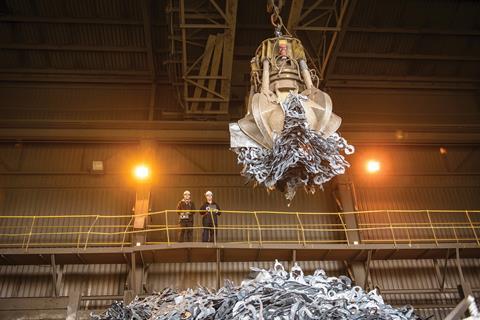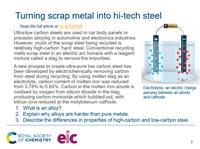How scientists are using electrolysis to meet the demand for low-carbon steel
Download this
A one-slide summary of this article with questions to use with your 14–16 students: rsc.li/3D6L8qN
A new process for electrochemically removing carbon from steel during recycling to create ultra-pure low-carbon steel has been developed. It’s believed that the technology required could be integrated into steel mills, allowing the recycling of high-carbon steel into higher-grade metal, which is in high demand for hi-tech industries.
Sectors such as the electronics and automotive industries are dependent on ultra-low carbon steels, sometimes needing carbon contents below 0.003% for thin car body panels or precision alloying. However, much of the scrap steel being recycled is relatively high-carbon steel. Carbon is removed from molten iron industrially by blowing oxygen through it. The process to reduce the carbon and produce ultra-low carbon steel often requires multiple stages and results in losing some of the metal.

During conventional recycling, scrap steel is melted in an electric arc furnace with a mixture of reagents called a slag to remove the impurities. So recycling facilities are already well-suited to use electricity. The researchers therefore developed a secondary process in which the molten slag was used as an electrolyte.
Put this in context
Add context and highlight diverse careers with our short career videos showing how chemistry is making a difference and let your learners be inspired by chemists like Zubera, a research fellow in battery recycling.
The team apply an electrochemical potential across the ceramic electrolyte between the molten iron and another electrode. The carbon in the molten iron anode is oxidised by oxygen from silicon dioxide in the slag, producing carbon monoxide which bubbles out. Silicon ions, meanwhile, are reduced to silicon at the molybdenum cathode.
This could potentially be used for alloying the recycled steel. The researchers found that their process reduced the carbon content of molten iron from 3.78% to 0.84%, and could refine iron with 0.005% carbon content down to 0.001%. They are now working to scale up the process and investigating the removal of other impurities using the same principle.
Read the full story in Chemistry World.
Downloads
EiC starter slide lowering carbon content in steel
Presentation | PDF, Size 0.18 mbEiC starter slide lowering carbon content in steel
Presentation | PowerPoint, Size 1.23 mb










No comments yet